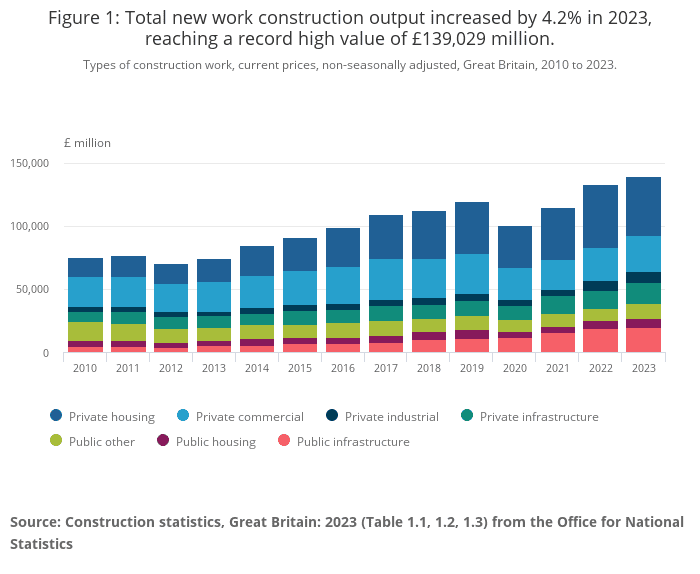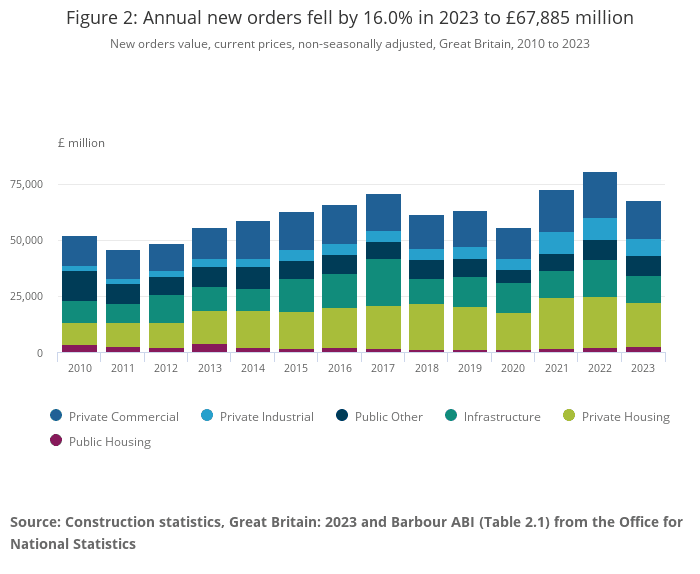The Office for National Statistics (ONS) has released their construction statistics for Great Britain in 2023, highlighting record-breaking growth as well as concerning decline in key areas
The ONS construction stats show that the value of construction new work reached a record high in 2023, growing by 4.2% to £139,029m.
This is attributed to a growth in private sector work (£2,050m) and public sector work (£3,578m).
Growth in critical metrics in 2023
Excluding self-employed construction workers, the statistics show that construction-related employees rose by 0.2% in 2023 from 2022, bringing the total to 1.4m workers.
Scotland’s 1.4% growth was the largest cause of this growth, followed by Wales’s 0.7% growth.
England showed no growth in employment.
The all-work construction Output Price Index saw an annual price growth of 2.6% in December 2023, reflecting the growth in private and public and showing that total new work increased by £5,628 million in 2023.
The PMI’s for October 2024 show that growth has continued into the year overall.

Concern for future growth as new orders fall
Not every statistic in the new release is positive. New orders declined 16% through 2023, amounting to £67,885m. This is due to falls in public infrastructure and private commercial and private housing. By contrast, public housing increased, possibly reflecting the Government’s commitment to 1.5m new homes by 2030.
There was also a decrease in the number of Value Added Tax (VAT) and Pay As You Earn (PAYE) registered construction firms in Q3 (July-September), dropping by 2.6% from 2022 to 364,514.
England saw the largest drop in these registered firms, decreasing by 9,476, a 2.8% drop from the same period in 2022. Scotland’s dropped by just 42, 0.2%.
This may reflect the worrying trend of construction firms falling into administration, which has continued into 2024, including construction giant ISG, which fell into administration in September.
2024 saw a low construction output as well, but with signs of recovery.

Industry reacts to the ONS construction statistics
Michael Wynne, co-founder of the housebuilder Q New Homes, said: “While we are coming to the close of 2024, we finally have the full picture on the state of the construction industry last year, and it’s a mixed bag in terms of the levels of investment versus the amount of properties being built.
“The value of construction projects increased to reach a new record high, which could simply be put down to the high levels of inflation we saw last year and its impact on the cost of building materials.
“However, it could also be the result of more investment into developments to make them built to last and more sustainable.
“At the same time, the 16% drop in new construction orders signals a concerning slowdown in future projects, especially in private housing, commercial spaces and public infrastructure. This decline risks limiting the availability of innovative, sustainable homes in the market.
“There was a drop in new orders for private housing last year which is a worrying sign that recent governments have not prioritised the need to build. However, it is positive to see public housing see a marginal rise, as cost-of-living concerns have shaken households and highlighted the greater need for affordable housing.
“We are building homes with their own renewable energy sources so that they are carbon-neutral and ultimately this costs more to build, but saves money on energy bills for the owner once it is sold.
“The current landscape presents a clear need for more investment in sustainable developments. Building net-zero homes not only offers a solution to the climate crisis but also long-term cost savings for homeowners.
“It is welcome news to see more people employed in construction. This is a thriving industry that is sometimes overlooked by school-leavers, but with such important milestones to work towards in terms of housebuilding and reducing carbon emissions, we need all hands on deck.”
Lauren Pamma, head of energy & infrastructure at Aldermore Bank, said: “Last year saw notable challenges for the construction industry, yet today’s data shows that businesses managed to push forward despite the setbacks. Higher interest rates and inflation dampened customers’ appetites for new projects and new orders from businesses, challenges in recruiting skilled workers persisted, and adverse weather towards the end of the year caused delays to work and hindered progress – this may be why new orders fell by 16%.
“However, 2023 saw a 4.2% rise from 2022 in the value of construction new work to £139,029m, which sets a new record high. It’s great to see both the private sector and public sector managing to drive growth throughout the year.
“The pressures on the industry started to ease towards the end of last year, and we started to see momentum being rebuilt in 2024. Construction SMEs have been focused on innovation and growth. Our research found that businesses were looking to invest £214,073 in growing their businesses this year (based on research conducted by Opinium on behalf of Aldermore between 16–22 April 2024 of 1,000 SME Senior Decision Makers), and coupled with recent rate cuts and the Government’s plans to increase housebuilding targets, 2024 should build on the rise in value of construction new work, while also seeing a rise in new orders.
“It’s important construction businesses can be empowered to optimise their financial resources and grow sensibly so that they can continue to deliver projects, especially as we look forward to 2025.”














